The Un-Ending Saga, Part 3
Two weeks ago, I explained the circuitous route Unstable took to becoming a set. Last week, I explained how Contraptions went from being a joke to a full-fledged mechanic. Today, I talk about all the other major elements in the set, including showing off a few cool preview cards. Hope that sounds fun. Let's get started.
"I'm Glad You Could Join Us"
I'll begin today with the other major mechanic of the set: host and augment. As with Contraptions, I'll start by explaining how the mechanic works. The set has a number of creatures with the supertype host. These look like normal creatures other than the fact that they have a metal bar running vertically through their art and a strange-looking text box.
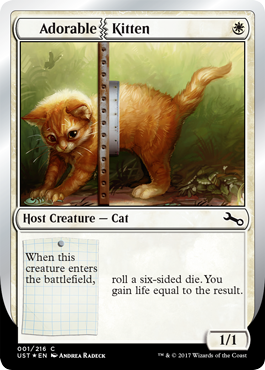
All host creatures have one and only one ability, an "enters-the-battlefield" (ETB) effect. (The one exception is a host creature that has flying in addition to its ETB effect.) Adorable Kitten, for example, has you roll a six-sided die when it enters the battlefield, and you then gain life equal to the die roll. (More on die-rolling below.) It's a 1/1 that can gain you anywhere from 1 to 6 life.
Augment is an ability found on specific creatures, all of which feature a strange card layout in that their right sides run to the card edge. You can see a vertical metal bar on the right side, much like the one that runs through the middle of the host creatures. Also, creatures with augment have no mana cost, so they can't be cast as normal. All creatures with augment have a trigger or an activation. Some have creature abilities. Most have a power/toughness box with plusses or minuses next to the numbers.
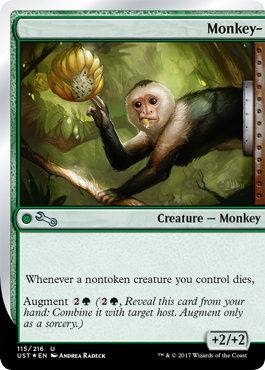
Monkey- has the "Whenever a nontoken creature you control dies" trigger and grants +2 power and +2 toughness.
Host creatures are played just like normal creatures. Creatures with augment, though, may only be played onto host creatures using the augment ability. When you augment a creature, you lay it on top of the host creature such that the metal bars line up, like so:
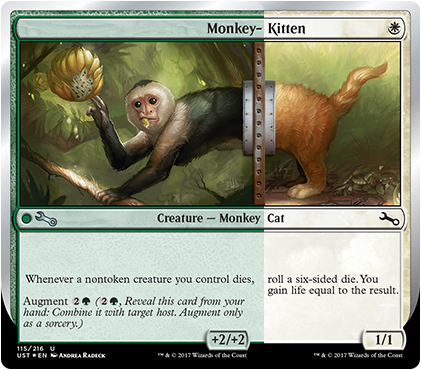
Adorable Kitten now becomes Monkey-Kitten. It's a 3/3 that gains you life equal to the result of a six-sided die roll whenever a nontoken creature you control dies. The easiest way to think of it is that the new creature basically has the abilities that are visible. The one exception is that the power and toughness are altered by the augment creature's power and toughness adjustments. Also, artifact host creatures keep their artifact status. That's why the artifact card type appears over to the right so it's not covered up. Creatures with augment that are artifacts make the host creature into an artifact creature. When combined, the creature will have the triggered or activated condition that leads to the effect on the host creature. Any creature with augment can join any host creature, but only a host creature, and only one augment per joining.
For all the rules about host and augment, check out the Unstable mechanics article.
The set has nineteen host creatures and thirteen creatures with augment, leading to 247 possible combinations. Note that host creatures tend to appear at lower rarities, and thus a higher as-fan, as it's important you have enough host creatures to be able to play your augment cards.
How exactly did this mechanic come to be? Interestingly, its origins start with Unglued. According to our market research, B.F.M. (Big Furry Monster) was the most popular card in the set.
For Unglued 2 (the set that never got made—you can read more about it here and here), I messed around with a mechanic where there were left sides and right sides of cards, basically B.F.M. with more modularity. Any left side could be joined to any right side. There were all sorts of problems, but here were the two biggest. The first was a visual problem: How do you make left and right sides that look good together no matter which left side and which right side you combine?
The second was a mechanical problem, what R&D refers to as an "A/B problem." In order to make the mechanic work, you have to have both an A part (the left side) and a B part (the right side). Get all A parts or all B parts and the mechanic doesn't work. B.F.M. worked partly because of the novelty and partly because we could do such a crazy payoff (a 99/99 creature) that it was worth it to try. A whole mechanic didn't have the option to do that. I couldn't solve either problem, so I shelved the idea. In Unhinged, I made this card:
S.N.O.T. was designed, both mechanically and visually, so it could keep combining with itself to get bigger and bigger. It touched upon what I was trying to do, but it only scratched the surface.
The idea of creatures that could be clicked together stuck with me, and various times in black-bordered Magic, various design teams tried to create creatures that could be combined together. The mechanic has had different names, but the most common one was "link." The basic idea was that the creatures, when linked, would combine their abilities and their power and toughness. For example, if I had a link creature that was a 2/2 with flying, I could combine it with my 3/3 with vigilance to create a 5/5 creature with flying and vigilance. As each creature could exist alone, the A/B problem was greatly lessened. We also played around with the idea that when the creature died, only one card would die—the other would stay on the battlefield.
Link was put into numerous sets and would often make it some of the way through design. The closest it ever came was in New Phyrexia, where it made it all the way to devign (the intermediary step between design and development) only to be changed to Phyrexian mana instead right before development. In the end, it was the rules that always killed the mechanic, as link has so many things it's trying to accomplish. The rules could never quite work out.
Fast-forward to Unstable design. We'd signed up to make mad scientist world, so the idea of trying to find a way to do link or something in that space seemed to make sense thematically. Being in silver-border world gave us access to new elements, especially more radical frame designs. Host and augment started with a simple idea: Was there a way to make a mechanic that had the flavor of combining two different creatures together?
As many of you might know, I'm a fan of the singer Jonathan Coulton (I'm the one who made Creepy Doll in Innistrad). He has a song called "Skullcrusher Mountain" about a mad scientist supervillain that's singing to a woman he's captured. There's a line, "I made this half-pony, half-monkey monster to please you," that's always tickled me. Was there a way for Magic to bring hybrid creatures like a half-pony, half-monkey to life in the game? (By the way, yes there is!)
The first big breakthrough was the idea that one of the two pieces should just be a creature and the second piece would add onto it. This helped greatly with the A/B problem, because now you could play A when you drew it. Yes, you still needed to draw B, but the cards weren't just sitting in your hand. This innovation led to the next, which was the idea that the cards would visually be combined. You would literally be able to combine the two cards to make a creature that was part one thing and part another. The second card would act like a creature Aura, in that it needed the first card to be on the battlefield first.
We played around with cards that each had abilities that added together, but it was clear we were missing something. The goal was that when you combined these two things you got something that was unique to this combination. How could we have the two parts mechanically link together? Meanwhile, we also had the problem of what the creature was doing before you added the second part.
One of the suggestions that came up was that we put an enters-the-battlefield trigger on the host creature, which would then be covered up by the augment card. That way the host creatures could do something while you were waiting around for the augment cards. In that version, the augment cards just added abilities and power and toughness. One day, we made a creature that granted what R&D calls curiosity ("When this creature deals combat damage to a player, draw a card"). In playtest, I put it on a card that had an enters-the-battlefield effect to draw a card. I said, "This is cool. When it enters it draws a card, and now whenever it hits my opponent, I draw a card."
You know how in movies there's a moment when a brilliant idea hits the protagonist. It's like a thunderbolt out of the sky. In reality, that doesn't actually happen all that often, but it happened here. The accidental crossing of the two abilities made me realize that triggered effects had the quality we were looking for. They needed both a trigger and an effect. What if the host creatures had the effect and the augment creatures had the trigger? All hosts would have an enters-the-battlefield trigger that would be overwritten when the creature became augmented. That would mean that as you mixed and matched augment creatures with host creatures, you would generate unique effects. We would later realize that we could also have activations in addition to triggers.
Once we had the main mechanics worked out, the next part was trying to nail down how the cards looked. The team really liked the idea that you were physically combining them. We spent a lot of time talking about what we wanted that to look like. Below are two proof-of-concept cards design team member Dan Emmons made to try and demonstrate how we could do this visually.
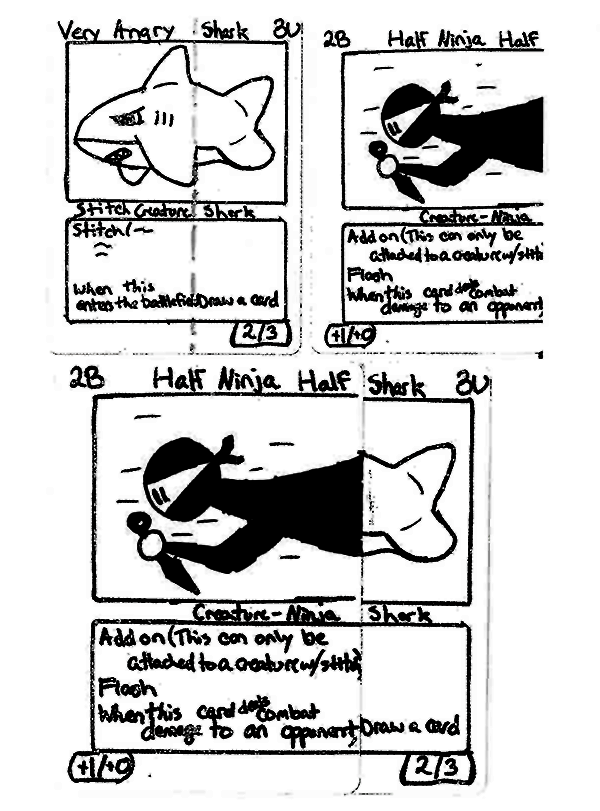
It's interesting that the finished cards are not too far away from Dan's images.
Once we had the structure and visual look figured out, the next part was making the cards. We wanted each host creature to have an interesting and unique effect, one that had some connection to its flavor, and we wanted each augment card to be an interesting and unique trigger or activation. It took us a while to nail down all the different parts, but once we were finished, we knew we had something special.
Do or Die
This next theme, the use of six-sided dice, came about because we were trying to find something that fit the following criteria:
- We wanted more high-variance cards. The Un- sets lean toward the non-competitive end of the spectrum; the audience is more focused on having fun than necessarily winning. (And yes, I know winning is fun.) That crowd enjoys more variance in their gameplay. Unknown outcomes and big swings can create a lot of cool drama.
- Unstable was going to be a small set drafted by itself. To maximize the repeatability of the gameplay, we wanted cards that had more potential outcome possibilities. If a card does one thing in Game 1, and then does something slightly different in Game 2 (even if it's just a different scale of the effect), the games play out differently.
- To capture the mad scientist vibe, especially for the Goblins, we wanted a feel of chaos. Part of what makes mad science fun is that you don't always know what you're going to get.
- We wanted something that didn't require a lot of words. Un- sets have some inherent complexity issues, as we avoid a lot of the simple space to save it for black-border Magic. A little excess complexity is allowable, as Un- sets aren't aimed at beginners, but we still don't want every card to be a block of text.
There was an easy answer to the above: dice rolling. There was just one problem. We had tried dice rolling in Unglued and it tested poorly in market research. So much so that I didn't put any dice rolling into Unhinged. There was no solution as good as dice rolling for this problem, though, so I decided it was time to go back and look at the data to see if I could understand what was making players dislike dice.
Here are the dice-rolling cards that got the lowest ratings:
Can you see what they have in common? Either they have random effects, making them hard to build around because you don't know what they're going to do, or they have the potential to not work and make you waste or lose the resource.
Here are the dice-rolling cards that got the highest ratings:
These were effects where you always got something, and sometimes, when you were lucky, you could get something bigger.
My research made me decide that dice rolling could be popular if we were careful about how the cards were designed. We avoided making dice-rolling cards, for instance, that didn't allow you to anticipate what they were going to do. The mystery was how big the effect would be, not what would happen. Also, we tried to avoid making cards where bad things happen to you if you roll poorly. Getting a tiny effect is punishment enough. There are a number of cards that have you roll two dice and the difference between them dictates the size of the effect, so you have the ability to miss in that you can get 0. Those effects are mostly kept to Contraptions, though, whose effects will usually happen multiple times.
For those who like to have a little more control, we put in a number of cards that help you manipulate dice rolls. Some let you reroll, some let you roll extra dice and pick which to include, and some allow you to increase the die rolls. I think we found a good mix that captures what players like about dice rolling while removing the things they don't like.
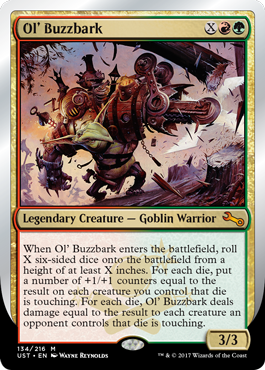
"Do You Have a Moment?"
Another theme that shows up on a number of cards is what R&D refers to as "outside assistance" cards. These are cards that require you to find a person not playing in your current game and ask them to do something—usually making a choice or choices about something that will impact your game.
This series came about because we were trying to find other ways to add some variance to the set. How can we make cards where the caster won't exactly know what's going to happen when they cast them? (Like dice rolling, we made most of the effects ones where you know generally what's going to happen, just not the specifics.) Also, we were looking for more ways to get fun interactions into the game. I always enjoy stories about how the whole game store gets in on the fun when playing an Un- set.
What if the random factor was other people? What if Unstable made you interact with people not playing your game? We tried a few in our playtesting, and wonderful things started to happen. The dynamic of bringing other people into the game proved a lot of fun, so we upped the theme to a cycle plus three additional cards. So be aware if you're even near an Unstable game—you might become involved.
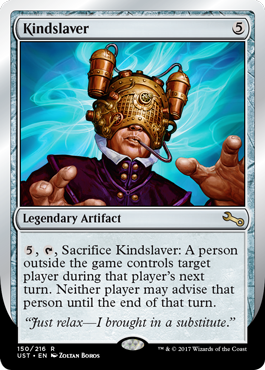
Watermark My Words
One of the rules for Un- sets is that the designs have to be things we wouldn't do in the black-bordered game. One of the ways I find things in this category is to try and do them in black-border Magic and be told that I can't. This brings us to watermarks. A watermark is an image that goes in the text box behind the text. Examples of watermarks are the guild symbols in Ravnica sets, the clan symbols in Khans of Tarkir block, the Mirrodin and Phyrexian symbols in Scars of Mirrodin block, and the Planeswalker symbol on the story spotlight cards.
Black-border Magic isn't allowed to mechanically care about watermarks, because we have a rule that all versions of a card with the same name (in English) are the same mechanically. Things that show up on some version of the cards but not others (such as the artist's name, expansion symbol, and watermark) are thus not allowed to be mechanically relevant. Unstable saw this opportunity and ran with it.
Because we were doing a faction set, we were able to use watermarks on cards and then make cards that care about those watermarks. There's a cycle of cards that care about the watermarks, one for each faction. There are also a bunch of others that care about watermarks in general, and a few that will even allow you to build decks around the watermark of your choice, including ones not in Unstable.
"Very S.N.E.A.K.-y, Sis"
I'm about out of time, but before I go, I have two preview cards for you. As today is Agents of S.N.E.A.K. Day, both are from that faction. (Also check out some puzzles I made to see another preview card.) The first is Sly Spy, a Spy with an ability caring about something black-border cards don't.
Click here to meet the Sly Spy

Next, we get a legendary creature whose name threaded a needle between Unglued's Ow and Unhinged's _____ (the card with no name). It's the master spy of the Agents of S.N.E.A.K., whose codename is just X. As you'll see, he's quite sneaky.
Click here to meet X

Keep an eye out for the Unstable Release Notes (which will be released later this week) for more in-depth explanation of how this card works.
Here Comes the Un
And that wraps up my three-column story on the design of Unstable. As usual, I want to hear your feedback, but as Unstable is a set near and dear to my heart, I'm even more interested than normal to hear what you have to say. So please, if you have any thoughts on the Unstable articles or the set itself, write to me through my email or contact me through any of my social media accounts (Twitter, Tumblr, Google+, and Instagram).
Join me next week when I start telling my card-by-card stories about Unstable.
Until then, may Unstable be as fun for you playing as it was for me making it.
#488: Unstable, Part 1
#488: Unstable, Part 1
35:16
The Un- sets are where I try new things, so it seemed only apropos to experiment with having the podcast be about the design when the set is being previewed. This is part 1 of 3.
#489: Unstable, Part 2
#489: Unstable, Part 2
41:03
This podcast is part 2 of 3 of the story of Unstable's design.
- Episode 487 Pitching (23.0 MB)
- Episode 486 Getting Unstable Made (21.7 MB)
- Episode 485 HASCON 2017 (24.5 MB)

